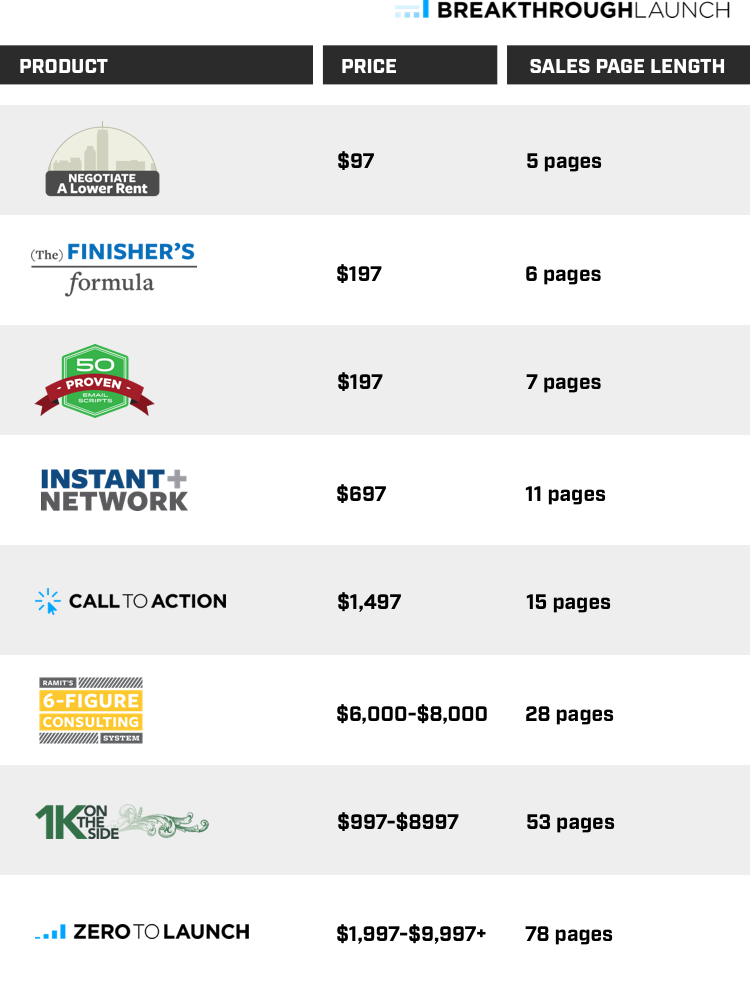
Top 5 questions we get on running $1,000,000 launches
Most of the time when I write an article for IWT, I focus on the big picture. I talk about psychology, mindset, and the frameworks you need as a CEO to build a successful business.
But today, I want to get tactical.
Over the past two years we’ve run well over a dozen successful product launches — one- to three-week email marketing campaigns that made 6 or 7 figures. Most companies are lucky to do two launches like that a year.
And I get dozens of questions about how we do it, and what it takes for a small business to pull off a $1,000,000+ launch.
Below are the answers to the 5 most common questions.
We’re going to move quickly, but If you’re in a place where you’re ready to use these answers, they’ll help you grow the revenue from your next launch 20-200%.
So let’s get started. 1. When should I do a webinar?
Webinars are a perennial hot topic in the marketing world. They’re live broadcasts where you teach the audience something about a problem they have, then sell them the solution. Lots of people use them to kick off the sales window in a product launch — and there are all sorts of myths and superstitions about the best night and time to do one.
Here’s the real answer: It doesn’t matter.
Seriously. I’d probably avoid December 25th and the Fourth of July… but other than that, it makes no difference.
You see, we’ve done webinars on Monday nights for 5-6 years.
But, back in late 2015, a lot of really credible experts in online direct response started saying that the secret to success was putting your webinars in the middle of the week.
They said that putting your webinars on a Wednesday or Thursday night would triple your attendance.
The logic was putting it on a Friday or on a Saturday night meant competing with the weekend. Nobody would show up because they were off drinking or doing things with their family and having fun.
And if you put webinars on a Monday or Tuesday night it was the beginning of the week and everybody was busy so no one would show up then either.
But if you put them on a Wednesday or Thursday… that was when the magic happens.
Now, this was something we were super interested in.
Webinars are one of our highest converting sales vehicles.
In fact, about a month before we wrote the page you’re reading now, we launched Endless Audience — our premium course on how to build a traffic engine for your products and your business.
About 10% of the people who were on the webinar when we introduced the product bought.
So we want as many people on our webinars as possible. If we can triple the number of people to webinars just by changing the night we do them, we were all for that.
But guess what happened when we tested changing the webinar night in an Earn1K launch in February 2016?
Nothing.
Our attendance rate didn’t even wiggle.
We even repeated the experiment a couple of different times and always found the same thing: Between 24-30% of people who registered would show up.
That’s pretty standard. If your readers care, and you’ve got a pretty good-sized list, you’ll get between 24-30% of people actually attending your webinar. Monday, Sunday, Wednesday, it doesn’t matter — you’ll probably fall somewhere in that range.
So stop worrying about what night you do it on. Choose one that works for your schedule and do it. 2. What kind of A/B tests should I run for my launches?
Most gurus tell you to “test everything,” but that’s impractical. Running A/B tests takes time, they take energy, you need to make sure that a lot of people see them to have a chance at statistical significance, and most importantly, 80-90% of the things you test will make no difference.
Unless you’re already big enough to have a dedicated growth or marketing team, or you’re running a $15,000+ monthly paid advertising budget, most A/B tests aren’t going to be worth your time.
A good rule for A/B testing is this: only test changes you think could 2X conversions or more.
Let me give you an example.
A couple of years ago our copy chief became obsessed with the idea that sending people to a sales page after a webinar was hurting sales.
He figured anyone who clicked on a “buy now” button after watching a 45-minute presentation was either a tire-kicker or ready to buy.
That idea would give most direct-response copywriters a heart attack — but he was adamant that taking the sales page out could double or triple sales.
So we tested it.
In September 2016, we hosted a webinar selling Earn1K — a $1,000+ product. We ran a split test and sent about 12% of people straight to the order form, rather than to the sales page.
Here’s what happened:

The people sent straight to the order form were 15X more likely to buy.
Why? We think it’s because those people are ready to buy. Slowing them down only gives them time to get cold feet and talk themselves out of the purchase.
But here’s an important thing about A/B tests. They don’t tell us why something works and we don’t really care about the why.
Test things you think will be big wins. Don’t waste time testing stuff that won’t move the needle — nobody cares what color your shopping cart button is.
Don’t waste time wondering why one test failed and another worked. Ninety-nine times in one hundred you’ll have no idea why one test failed and another worked.
Pocket the wins, write off the losses, and get on with running your business. 3. What’s a good open/click through rate for my emails?
Want to know how your open rate stacks up to other people in your industry?
Done. Here are the averages for some of the most common industries our students build businesses in.



Source: MailChimp Email Marketing Benchmarks 2017
And if you want an almost painful level of detail on dozens of industries, MailChimp and Constant Contact both publish benchmark reports annually. 4. Do I really have to write a new launch every time?
Can I reuse emails?
The bad news is running a launch involves writing a lot of emails. Over the course of the launch you’ll be emailing your readers three to ten times a week for two or three weeks.
That’s a lot of content to write.
The good news is you don’t have to write new emails for every launch. That would be insane.
You can reuse emails and even entire launches without anyone ever noticing.
We’ve sent out launches where up to 50% of the emails were similar or identical to ones from launches we’d sent out before with the subject lines changed.
There wasn’t any difference in performance versus new launches — many of those made more than $1,000,000 the second time around — and none of our readers noticed.
Why is it people didn’t notice? Are all our readers just forgetful?
No.
It’s just there are 2 fundamental truths about running a product business:
- Many of your sales will come from new leads. Unless you’re releasing a brand new product, people on your list will have either bought after 90 days or they’re probably never going to buy.
- Honestly, you just aren’t that important to your readers. Remember a GOOD open rate is 25%. That means 75% of your readers never saw the email in the first place. And even if they did, most people have better things to do than remember what emails you sent 19 months ago.
That doesn’t mean you should just send the same emails out over and over again. Leading with fresh creative is a cornerstone of our strategy and we spend a lot of time creating new and valuable content for our readers.
But if we’re answering questions about a product we’ve launched three times, yeah, we can certainly reuse our tested and proven FAQ email. You can too. 5. How long should my sales page be?
How do I tell if it’s good enough?
Is your product less than $700?
If so, don’t waste time writing 45+ pages of copy.
You’re better off with 2-5 pages of really good copy than 20 mediocre pages.
That’s what we do.
And if you’re thinking about the 78-page sales letter we wrote for Zero to Launch, consider this for a second.
That page is the exception, not the rule.
You need good copy, not necessarily long copy, and we actually have far more short sales pages than we have long ones.
In fact, here’s what happens when you type out some of the sales pages for our other products in a normal font:



Those first five products have made this company millions of dollars — and none of them are longer than 15 pages.
And how do you tell if the copy is good enough?
Hate to say it, but there is really only one way: You can run a launch and see if people buy.
That’s it. Those are the answers to the 5 most common questions I get about product launches.
If you have any questions I missed let me know in the comments — we’ll either answer them there or save them for a future article.
Learn to take control of your finances and spend your money GUILT-FREE with our free Ultimate Guide To Personal Finance below:
In September 2016, we hosted a webinar selling Earn1K — a $1,000+ product. We ran a split test and sent about 12% of people straight to the order form, rather than to the sales page.
Here’s what happened:



The people sent straight to the order form were 15X more likely to buy.
Why? We think it’s because those people are ready to buy. Slowing them down only gives them time to get cold feet and talk themselves out of the purchase.
But here’s an important thing about A/B tests. They don’t tell us why something works and we don’t really care about the why.
Test things you think will be big wins. Don’t waste time testing stuff that won’t move the needle — nobody cares what color your shopping cart button is.
Don’t waste time wondering why one test failed and another worked. Ninety-nine times in one hundred you’ll have no idea why one test failed and another worked.
Pocket the wins, write off the losses, and get on with running your business. 3. What’s a good open/click through rate for my emails?
Want to know how your open rate stacks up to other people in your industry?
Done. Here are the averages for some of the most common industries our students build businesses in.



Source: MailChimp Email Marketing Benchmarks 2017
And if you want an almost painful level of detail on dozens of industries, MailChimp and Constant Contact both publish benchmark reports annually. 4. Do I really have to write a new launch every time?
Can I reuse emails?
The bad news is running a launch involves writing a lot of emails. Over the course of the launch you’ll be emailing your readers three to ten times a week for two or three weeks.
That’s a lot of content to write.
The good news is you don’t have to write new emails for every launch. That would be insane.
You can reuse emails and even entire launches without anyone ever noticing.
We’ve sent out launches where up to 50% of the emails were similar or identical to ones from launches we’d sent out before with the subject lines changed.
There wasn’t any difference in performance versus new launches — many of those made more than $1,000,000 the second time around — and none of our readers noticed.
Why is it people didn’t notice? Are all our readers just forgetful?
No.
It’s just there are 2 fundamental truths about running a product business:
- Many of your sales will come from new leads. Unless you’re releasing a brand new product, people on your list will have either bought after 90 days or they’re probably never going to buy.
- Honestly, you just aren’t that important to your readers. Remember a GOOD open rate is 25%. That means 75% of your readers never saw the email in the first place. And even if they did, most people have better things to do than remember what emails you sent 19 months ago.
That doesn’t mean you should just send the same emails out over and over again. Leading with fresh creative is a cornerstone of our strategy and we spend a lot of time creating new and valuable content for our readers.
But if we’re answering questions about a product we’ve launched three times, yeah, we can certainly reuse our tested and proven FAQ email. You can too. 5. How long should my sales page be?
How do I tell if it’s good enough?
Is your product less than $700?
If so, don’t waste time writing 45+ pages of copy.
You’re better off with 2-5 pages of really good copy than 20 mediocre pages.
That’s what we do.
And if you’re thinking about the 78-page sales letter we wrote for Zero to Launch, consider this for a second.
That page is the exception, not the rule.
You need good copy, not necessarily long copy, and we actually have far more short sales pages than we have long ones.
In fact, here’s what happens when you type out some of the sales pages for our other products in a normal font:



Those first five products have made this company millions of dollars — and none of them are longer than 15 pages.
And how do you tell if the copy is good enough?
Hate to say it, but there is really only one way: You can run a launch and see if people buy.
That’s it. Those are the answers to the 5 most common questions I get about product launches.
If you have any questions I missed let me know in the comments — we’ll either answer them there or save them for a future article.
Written by Ramit Sethi
Host of Netflix’s “How To Get Rich” NYT Bestselling Author, & Host of the I Will Teach You To Be Rich Podcast. I’ll show you how to take control of your money with my proven strategies so you can live your RICH LIFE.



